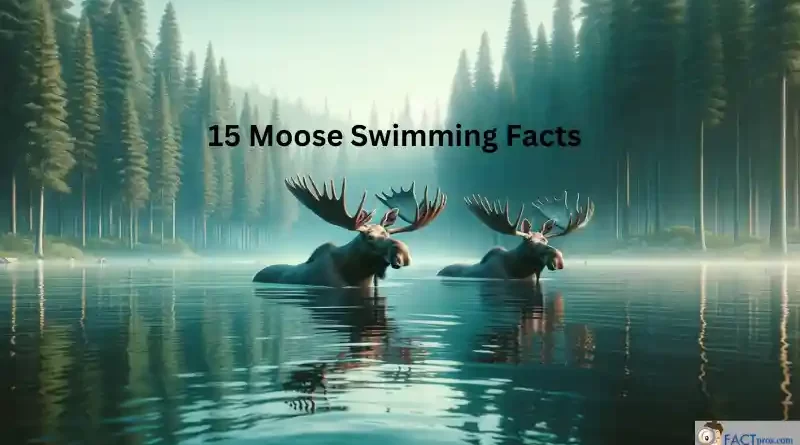Diving Deep into 15 Moose Swimming Skills: A Guide to Their Aquatic Abilities
Moose Marvels: Unveiling Their Surprising Aquatic Skills
Hello, fellow nature enthusiasts! I’m Julie, a writer at FactPros.com, and today, we’re diving (literally!) into the fascinating world of moose and their swimming abilities. Let’s embark on this aquatic adventure and discover some astonishing facts about these majestic creatures.
Moose 101: Understanding the Basics
Before we jump into the water, let’s set the scene with some basic moose facts. Moose are the largest members of the deer family. Imagine seeing one in the wild – they’re huge! With their towering presence and distinctive antlers, they are truly a sight to behold.
Anatomy of a Moose
Firstly, the anatomy of a moose is a marvel. Their long legs, which are great for traversing deep snow, also aid in swimming. And those antlers? Not just for show – they play a role in the moose’s life beyond just looking majestic.
Habitat and Distribution
Moose are found in the northern regions of North America, Europe, and Asia. They love cold climates and are often found near lakes and rivers. This preference hints at their hidden aquatic talents.
Moose and Water: A Surprising Relationship
Now, let’s wade into the more exciting part – moose and their relationship with water. Moose aren’t just casual swimmers; they’re quite adept in the water.
Swimming Skills of Moose
Did you know that moose can swim up to 6 miles without a break? That’s like swimming across a whole lake! Their long legs aren’t just for show – they make excellent paddles.
Moose Diving Abilities
Moose can dive up to 20 feet deep. Imagine holding your breath and diving to find your dinner – that’s a daily routine for these guys.
The Necessity of Swimming for Moose
So, why do moose swim? It’s not just for fun. Swimming is a crucial part of their survival.
Foraging for Food
In search of aquatic plants, moose take the plunge. These plants are a vital part of their diet, especially in summer.
Escape from Predators
Water is also a safe haven for moose. When a predator is on their tail, they often head for the water – a smart move when you’re such a strong swimmer.
The Impact of the Environment on Moose Swimming
The environment plays a huge role in the life of a swimming moose.
Climate Change and Moose Habitats
As our climate changes, so do the habitats of moose. This affects their access to food and safe swimming areas.
Human Interactions
Our presence in moose habitats can be both good and bad. It’s important to coexist respectfully with these majestic creatures.
Protecting Our Swimming Giants
Lastly, let’s talk about protecting these incredible swimmers.
Conservation Efforts
Conservation is key. Ensuring that moose have safe and healthy environments to live and swim in is crucial for their survival.
The Role of Education
Educating people about moose and their needs is vital. The more we know, the better we can coexist with and protect these amazing animals.
In conclusion, moose are not just land giants but also skilled swimmers with unique adaptations for aquatic life. Understanding and protecting these creatures ensures that they continue to thrive in their natural habitats. So, the next time you see a moose, remember, there’s more to them than meets the eye – especially when it comes to their surprising swimming abilities!
Moose Swimming Skills: A Quick Glance
| No. | Fact | Detail |
|---|---|---|
| 1 | Size and Strength | Moose are the largest members of the deer family which means they are kin to the memorable reindeer. Moose are equipped with powerful legs for swimming. |
| 2 | Anatomy Advantages | Their long legs, useful for walking in deep snow, double as excellent paddles in water. |
| 3 | Preferred Habitats | Moose are often found near lakes and rivers, indicating a natural inclination towards water. |
| 4 | Swimming Stamina | They can swim up to 6 miles without taking a break, showcasing remarkable endurance. |
| 5 | Diving Depth | Moose can dive up to 20 feet deep in search of food. |
| 6 | Aquatic Foraging | They forage for aquatic plants, which are a crucial part of their diet, especially in summer. |
| 7 | Escape Tactics | Water serves as a refuge from predators, leveraging their swimming prowess for safety. |
| 8 | Swimming Speed | Moose can swim with surprising speed up to 6mph or about 9.7 kilometers per hour for 2 hours, outpacing many human swimmers. |
| 9 | Year-Round Swimmers | They swim in both summer and winter, showing their adaptability to different seasons. |
| 10 | Calf Training | Moose calves start swimming at a very young age, learning essential survival skills. |
| 11 | Underwater Grazing | They are one of the few animals that can graze underwater. |
| 12 | Heat Regulation | Swimming helps moose regulate their body temperature during warmer months. |
| 13 | Migratory Swims | Some moose swim long distances to reach new habitats or find mates. |
| 14 | Impact of Climate Change | Changing climates affect their swimming habits and access to aquatic food sources. |
| 15 | Human Interaction Effects | Human activities can impact their natural swimming behaviors and habitat safety. |
Moose Aquatics: Unveiling Their Hidden Swimming Talents
Hello, nature lovers! It’s Julie from FactPros.com, back again with another wild adventure. Today, we’re diving into the surprisingly aquatic world of moose! Yes, you heard that right – moose, those giant, antlered creatures, are also skilled swimmers. So grab your snorkels, and let’s splash into the world of moose swimming!
The Mighty Moose: A Swimming Phenomenon
You might know moose as the towering giants of the forest, but there’s so much more to these creatures than meets the eye. Imagine a creature that’s as at home in the water as it is on land – that’s the moose for you!
Anatomy: Designed for Aquatic Excellence
Firstly, let’s talk about what makes a moose such a great swimmer. Their long, powerful legs, which help them wade through deep snow, also double as excellent swimming aids. These legs aren’t just for walking; they’re like natural paddles, propelling them through water with ease. And those impressive antlers? Well, they’re not just for show. They help balance and steer while swimming.
Moose Habitat: A Water-Lover’s Paradise
Moose typically live in forested areas that have access to large bodies of water, like lakes and rivers. This isn’t a coincidence. Moose are naturally drawn to water, not just for drinking but also for foraging and staying cool. They’re not your typical backyard deer; these guys are more like the professional swimmers of the forest!
The Moose’s Aquatic Arsenal: A Deep Dive into Skills
Moving beyond just the basics, it’s time to explore the incredible swimming abilities of moose in detail. These skills are not just impressive; they are essential for their survival and day-to-day life.
Moose as Marathon Swimmers
Imagine swimming across a whole lake without stopping. That’s what moose can do! They can swim up to 6 miles at a stretch. This isn’t just a short dip; it’s a marathon in the water. This incredible endurance is vital for traversing large bodies of water, whether they’re searching for new feeding grounds or escaping predators.
The Diving Moose: An Underwater Forager
Now, let’s dive a bit deeper, quite literally! Moose are known to dive up to 20 feet to reach aquatic plants. These plants form a significant part of their diet, especially in the summer months. This ability to dive and forage underwater is unique among large land mammals and speaks volumes about their adaptability.
Why Do Moose Swim? More Than Just a Cool Dip
It’s intriguing to consider why moose are such adept swimmers. It turns out, their swimming skills are crucial for more than just cooling off on a hot summer day.
Survival and Foraging
Moose swimming isn’t just about survival from predators. It’s also about food. The aquatic plants they consume are rich in minerals and provide a substantial part of their nutrition. Without their ability to swim and dive, accessing these vital food sources would be a challenge.
Escaping the Unseen Dangers
Another compelling reason for their swimming prowess is predator avoidance. In water, moose can escape from bears and wolves, their primary land predators. The water provides a sanctuary where these large mammals can use their size and strength to their advantage.
The Impact of Environment on Moose Aquatics
Our journey wouldn’t be complete without understanding how the environment affects the swimming habits of moose.
Climate Change and Its Effects
Climate change is altering the natural habitats of moose, affecting their access to both land and aquatic food sources. As their environment evolves, so must their swimming and foraging habits. This adaptation is crucial for their survival in a rapidly changing world.
Human Impact on Moose Habitats
The presence of humans in moose habitats can be both beneficial and detrimental. Our conservation efforts can help protect their natural environments, but at the same time, urban expansion and pollution pose significant threats to their aquatic habitats.
Moose’s Aquatic Mysteries
As we dive deeper into the aquatic world of the moose, it’s essential to appreciate the intricate ways these animals have adapted to their environments. Their swimming abilities are not just for show; they’re a testament to their resilience and adaptability.
The Technique Behind the Paddle
Let’s zoom in on the actual swimming technique of a moose. When they swim, their long legs perform a graceful yet powerful paddle movement. This motion is not just about moving forward; it’s about stability and maneuverability. Their hooves are specially adapted to work as natural flippers, providing both propulsion and direction.
The Role of Antlers in Swimming
Now, what about those magnificent antlers? During swimming, they might seem like a cumbersome addition, but in reality, they serve an important purpose. They act as natural floatation devices, helping to keep the moose’s head above water. This is particularly crucial when they dive, as it aids in quickly resurfacing.
The Seasonal Aspects of Moose Swimming
Moose swimming behavior changes with the seasons, reflecting their adaptability to different environmental conditions.
Summer Swims: Foraging and Cooling Off
In summer, swimming serves multiple purposes for moose. It’s a way to cool off in the heat and a method to access lush, underwater vegetation. These plants are not just food; they are a vital source of hydration during the dry months.
Winter Waters: Survival Strategies
In winter, moose use their swimming skills differently. They might break through ice to access food or escape predators in a landscape where mobility is limited due to snow. Their ability to swim in cold, icy waters is a testament to their hardiness and survival instincts.
The Moose’s Swimming and Its Ecosystem Impact
The swimming habits of moose have a broader impact on the ecosystems they inhabit.
Aquatic Ecosystem Contributions
Moose play a role in shaping the aquatic ecosystems they frequent. Their foraging helps control the growth of aquatic plants, contributing to the health and balance of their habitats. This interaction is a perfect example of how animals and their environments are interconnected.
The Ripple Effect of Moose Swimming
The presence of swimming moose can influence other species in the ecosystem. Their movement through water bodies can create paths for smaller animals and help circulate nutrients in the water, demonstrating the interconnectedness of nature’s web.
The Underwater World of the Moose: Diving Deep
Moose are not just surface swimmers; they are adept divers, exploring the depths of their aquatic habitats. Their ability to dive is not just a quirky trait but a crucial survival skill.
Diving Depths: Going Beyond the Surface
One of the most astonishing aspects of moose swimming is their ability to dive deep underwater. Moose can dive up to an impressive 20 feet deep. This skill is essential for reaching aquatic plants that grow at the bottom of lakes and rivers. When they dive, it’s a silent, graceful descent into a world that few other large land mammals ever experience.
The Purpose Behind the Dive
Why do moose dive so deep? The answer lies in their diet. Aquatic plants like water lilies and pondweed are nutritious and a significant part of their summertime diet. By diving, moose can access these valuable food sources, which are often beyond the reach of other herbivores.
The Physiological Adaptations for Moose Diving
Diving to such depths requires specialized physiological adaptations. Moose have evolved unique traits that enable them to thrive underwater.
Breath-Holding Capabilities
Moose have an exceptional ability to hold their breath underwater. This skill is crucial for their extended dives. Their large size and lung capacity enable them to take in and store enough oxygen to sustain themselves while submerged.
Buoyancy and Body Adaptation
Moose have a body design that aids in their diving. Their buoyancy is carefully balanced – heavy enough to sink, yet light enough to easily resurface. This balance is crucial for efficient diving and foraging.
The Ecosystem Effects of Moose Diving
The diving behavior of moose has broader implications for their ecosystems.
Impact on Aquatic Plant Life
Moose diving affects the aquatic plant life in their habitats. By feeding on certain plants, they help maintain a balance in the aquatic ecosystem. This selective foraging can prevent overgrowth of certain plant species, promoting a diverse and healthy underwater environment.
Creating Opportunities for Other Species
The activity of diving moose also benefits other species. Their movement stirs up the sediment and nutrients, aiding in the distribution of these resources throughout the water body. This can create feeding opportunities for fish and other aquatic organisms, showcasing the interconnectedness of ecosystem dynamics.
The diving prowess of moose is a remarkable adaptation, showcasing their versatility and resilience. From their impressive diving depths to their role in aquatic ecosystems, these creatures continue to amaze us with their capabilities. Their underwater world is as rich and complex as their life on land, highlighting the importance of preserving these unique habitats. 🌊🌿🦌
The Seasonal Shifts in Moose Swimming Behavior
Moose swimming behavior isn’t static; it changes with the seasons, reflecting their adaptability to the environment. This adaptability is key to their survival and well-being throughout the year.
Summer Swims: The Quest for Nutrition and Comfort
In the warmer months, moose swimming is predominantly driven by the need for food and temperature regulation. The warm summer weather encourages the growth of lush aquatic vegetation, which is a crucial component of the moose diet. Moose often spend hours submerged, feeding on this vegetation.
Additionally, swimming in summer offers a much-needed respite from the heat. Moose, with their thick fur, are prone to overheating, and water bodies provide a natural cooling system. This behavior also helps them avoid insect pests, which are less prevalent over water.
Winter Waters: Survival in the Snow
During the colder months, the role of swimming shifts dramatically for moose. As snow blankets their terrestrial habitats, mobility becomes challenging. In these conditions, water bodies can serve as easier pathways for travel, especially when rivers and lakes are partially frozen.
Moreover, in winter, when food is scarce on land, moose may break through thin ice to access aquatic plants that continue to grow beneath the surface. This ability to forage in winter is a vital survival mechanism, ensuring they have a consistent food source throughout the year.
Understanding the Threats to Moose Aquatic Habitats
While exploring the moose’s swimming abilities, it’s essential to acknowledge the threats facing their aquatic habitats.
Environmental Challenges
Climate change poses a significant threat to moose habitats. Rising temperatures and changing precipitation patterns can alter the aquatic ecosystems, affecting the availability of their food sources. In some regions, warmer temperatures have led to the proliferation of parasites and diseases, which can be detrimental to moose health.
Human Influences
Human activity also plays a role in shaping moose habitats. Deforestation, urban development, and pollution can all impact the quality and accessibility of water bodies for moose. Conservation efforts are critical in preserving these environments, ensuring that moose, and other wildlife, have the necessary resources to thrive.
In understanding the nuances of moose swimming behavior and the challenges they face, we gain a deeper appreciation for these magnificent creatures. Their adaptability to different seasons and environments is a remarkable aspect of their survival. As we continue to explore the world of moose, let’s remember the importance of protecting their natural habitats for future generations.
The Role of Swimming in Moose Social Behavior
Moose swimming isn’t just about survival and foraging; it also plays a part in their social behavior and interactions.
Mating and Swimming
During the mating season, swimming takes on a new significance for moose. Bulls (male moose) might swim across bodies of water in search of cows (female moose). These aquatic journeys are crucial for finding mates and ensuring genetic diversity within populations.
Teaching the Young: Moose Calves in Water
Swimming is also a family affair for moose. Calves learn to swim at a very young age, often within days of birth. This early introduction to water is vital for their survival, teaching them essential skills for foraging and escaping predators. Watching a mother moose teach her calf to swim is a touching and remarkable sight, showcasing the strong bond and teaching instincts of these animals.
Moose Swimming: A Spectacle of Nature
The swimming abilities of moose offer a unique spectacle in the natural world, attracting wildlife enthusiasts and nature photographers.
A Sight to Behold
The sight of a moose swimming, with its massive body gliding gracefully through the water, is a breathtaking and somewhat surreal experience. This display of power and elegance in water is a testament to the diverse capabilities of wildlife.
Ecotourism and Wildlife Watching
In some regions, moose swimming has become a draw for ecotourism. Observing these creatures in their natural habitat, especially engaging in activities like swimming, provides an invaluable opportunity to connect with nature and appreciate the importance of wildlife conservation.
The Future of Moose Swimming Habitats
As we wrap up our exploration, it’s crucial to consider the future of moose and their aquatic habitats.
Conservation Efforts
Effective conservation strategies are needed to protect the natural habitats of moose. This includes preserving water quality, maintaining natural vegetation, and ensuring safe migratory routes that include access to water bodies.
The Role of Community and Policy
Community involvement and informed policy decisions are vital in protecting moose habitats. Public awareness and education about these majestic creatures and their needs can lead to better conservation practices and policies, ensuring that moose continue to thrive in their natural environments.
Moose Migration and the Role of Water
Moose are known to migrate seasonally, and their swimming capabilities play a crucial role in these migrations.
Navigating Natural Waterways
Moose use rivers and lakes as natural pathways during their migrations. These waterways can lead them to new feeding grounds, mating areas, or more suitable climates. Their ability to swim across large bodies of water is essential in overcoming geographical barriers that would be impassable on land.
Adapting to Seasonal Changes
As seasons change, so do the habitats and food sources for moose. They migrate to find optimal living conditions, and water bodies often guide these journeys. In spring, they might move to areas with abundant aquatic vegetation, while in winter, they seek locations with less snow and accessible food.
The Significance of Moose in Cultural and Natural Heritage
Moose hold a special place in the cultural and natural heritage of many regions.
Moose in Indigenous Cultures
For many Indigenous communities, moose are a symbol of strength, endurance, and survival. They are often featured in folklore and art. These communities have coexisted with moose for centuries, understanding and respecting their role in the ecosystem.
Moose as a Symbol of Wilderness
Moose are often seen as a symbol of the wild and unspoiled natural world. Their presence in an area is a sign of a healthy and balanced ecosystem. Their majestic appearance and unique behaviors, including swimming, captivate the imagination, reminding us of the wonders of the natural world.
Engaging the Next Generation in Moose Conservation
As we uncover the many facets of moose life, it’s vital to engage younger generations in their conservation.
Education and Awareness
Educating young people about moose, their habitats, and the challenges they face is crucial. This can be achieved through wildlife programs, school curricula, and interactive experiences that foster a connection with nature.
Involvement in Conservation Efforts
Encouraging active participation in conservation efforts can empower the next generation. This can include community projects, citizen science programs, and advocating for sustainable environmental policies.
Moose are excellent swimmers. They can swim up to 6 miles without a break and are known to dive as deep as 20 feet to forage for aquatic plants.
Moose can swim at impressive speeds up to 6 mph. While exact speeds vary, they are often fast enough to outpace humans and evade predators in water.
Do moose use swimming for purposes other than travel?
Moose calves start learning to swim at a very young age, often within days of birth, under the guidance of their mothers.
Swimming is vital for moose survival, as it allows access to essential food sources, provides a means of escape from predators, and is crucial for migrating to different habitats.






